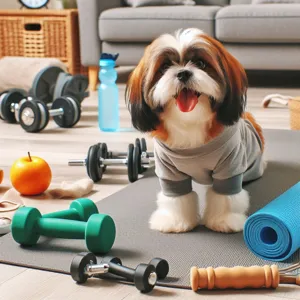As any seasoned golfer knows, the key to a successful round on the links often begins long before you step onto the first tee.
An effective warm-up routine is crucial for enhancing both performance and enjoyment of the game. Whether you’re a weekend warrior looking to improve your swing or a seasoned pro aiming to shave those crucial strokes off your score, incorporating essential warm-up exercises can make all the difference. In this blog post, we’ll explore a variety of dynamic stretches, mobility drills, and specific practice techniques designed to elevate your golf game. By taking the time to properly prepare your body, you’ll not only increase your flexibility and strength but also reduce the risk of injury, allowing you to fully embrace the thrill of each shot. get ready to unlock your potential and take your game to new heights with these essential warm-up routines!
1. The Importance of Warm-Up for Golf Performance

The Importance of Warm-Up for Golf Performance
Before you step onto the lush greens and into the competitive arena of golf, it’s crucial to recognize that a proper warm-up is not just a routine—it’s a foundation for success. Much like a finely tuned instrument, your body needs to be prepared to perform at its best, and warming up serves to enhance both your physical and mental readiness.
A well-structured warm-up routine increases blood flow to your muscles, elevating your heart rate and promoting flexibility. This is essential for golf, where every swing, putt, and drive requires a combination of strength, coordination, and precision. By warming up, you reduce the risk of injury, ensuring that your muscles and joints are primed for the dynamic movements involved in your game.
Moreover, a warm-up is not solely about physical preparation; it’s also a mental cue that signals your brain to transition into a focused mindset. As you engage in stretching and practice swings, you give yourself the opportunity to visualize your shots and strategize your approach for the day ahead. This ritual creates a sense of calm and concentration that can enhance your confidence as you step onto the first tee.
Incorporating a variety of dynamic stretches and sport-specific movements can help improve your range of motion and promote better swing mechanics. From gentle torso rotations to leg swings, these movements warm up the muscle groups most engaged in your game, allowing for a more fluid and powerful swing.
Ultimately, a thoughtful warm-up routine is an investment in your golf performance. It sets the tone for your game, allowing you to play not just with skill, but with the assurance that your body is ready for the challenge. So, before you grab your clubs, take the time to warm up—your game will thank you!
2. Understanding Golf-Specific Muscle Groups
Understanding Golf-Specific Muscle Groups is crucial for any golfer looking to enhance their performance on the course. Golf is a unique sport that requires a combination of strength, flexibility, and coordination, and it heavily relies on specific muscle groups that contribute to a powerful and accurate swing.
The primary muscle groups involved in golf include the core, legs, and upper body. The core muscles, including the abdominals, obliques, and lower back, play a pivotal role in maintaining stability and balance throughout your swing. Engaging these muscles not only helps with power generation but also ensures that your swing remains controlled and precise.
Your legs, particularly the quadriceps, hamstrings, and glutes, provide the necessary foundation for your stance and swing. Strong legs are essential for maintaining stability during the swing and transferring energy efficiently from the ground up. Additionally, they play a significant role in your follow-through, helping you maintain balance as you finish your shot.
Upper body strength is equally important. The shoulders, chest, and arms are vital for generating clubhead speed and controlling the direction of your shots. Developing strength in these areas helps you achieve a more powerful swing while reducing the risk of injury.
Incorporating exercises that target these muscle groups into your warm-up routine can significantly improve your golf game. Focus on dynamic stretches and strength-building movements that engage your core, legs, and upper body. For instance, exercises like medicine ball rotations, lunges with rotation, and resistance band shoulder stretches can enhance your mobility and strength, setting the stage for a successful round of golf.
By understanding and strengthening these golf-specific muscle groups, you not only prepare your body for the physical demands of the game but also give yourself a competitive edge, allowing you to swing with greater efficiency and confidence.
3. Pre-Round Stretching: Benefits and Techniques

Before stepping onto the course, integrating a solid pre-round stretching routine can be a game-changer for your golf performance. Stretching not only prepares your muscles for the dynamic movements required in golf but also enhances your overall flexibility and range of motion, which can lead to more powerful swings and improved accuracy.
**Benefits of Pre-Round Stretching**
The primary benefit of pre-round stretching is injury prevention. Golf involves repetitive motions that can strain muscles and joints, particularly in the back, shoulders, and wrists. By engaging in targeted stretches, you help to warm up these muscle groups, promoting better blood circulation and reducing the risk of injuries. Additionally, stretching can alleviate tension and stiffness, allowing you to maintain optimal posture throughout your game. Improved flexibility can also lead to a more fluid swing, translating into greater distance and control.
**Techniques to Incorporate**
To maximize the benefits of your pre-round stretching routine, consider incorporating a variety of dynamic stretches tailored to the movements involved in golf. Here are a few effective techniques:
1. **Torso Rotations:** Stand with your feet shoulder-width apart and gently rotate your torso from side to side, allowing your arms to swing naturally. This movement helps loosen your spine and prepare your hips for the rotational demands of your swing.
2. **Hip Openers:** Stand on one leg and bring your opposite knee up towards your chest, then rotate it out to the side and back down. Alternate legs to enhance hip flexibility, crucial for a powerful swing.
3. **Shoulder Stretch:** Extend one arm across your body at shoulder height and gently pull it in with your opposite hand, feeling the stretch in your shoulder and upper back. Repeat on both sides to ensure balanced mobility.
4. **Lunging Stretch:** Take a step forward into a lunge position, keeping your back leg straight and your front knee aligned over your ankle. This stretch opens up your hips and strengthens the muscles needed for stability during your swing.
5. **Wrist Flexor Stretch:** Extend one arm in front of you with your palm facing upward. With your other hand, gently pull back on your fingers to stretch the wrist and forearm. This is especially important for grip strength and control.
Incorporating these stretches into your pre-round routine can take just 10-15 minutes but will set the tone for a successful day on the course. Not only will you feel physically prepared, but you’ll also boost your confidence, allowing you to focus on your game rather than any lingering tightness or discomfort. By prioritizing pre-round stretching, you’re not just warming up your body; you’re priming your mind for an engaging and rewarding golfing experience.
4. Dynamic Warm-Up Exercises for Golfers
Dynamic warm-up exercises are an essential component of any golfer’s pre-game routine, as they prepare your body for the specific movements and demands of the sport. Unlike static stretches, which hold the muscle in one position, dynamic warm-ups involve controlled movements that increase heart rate, improve flexibility, and enhance coordination. Engaging in these exercises can help prevent injuries, improve your swing mechanics, and elevate your overall performance on the course.
Begin with some basic movements that engage the major muscle groups used in golf. Start with arm circles, where you extend your arms out to the sides and make small circles, gradually increasing the size. This will help warm up your shoulders, which are crucial for a powerful swing. Follow this with torso twists, where you stand with your feet shoulder-width apart and rotate your upper body from side to side. This exercise activates your core and mimics the rotational movement of your swing.
Next, incorporate leg swings to target the hips and legs. Stand next to a wall or a sturdy object for support, and swing one leg forward and backward in a controlled manner. This movement not only increases hip flexibility but also engages your lower body, which plays a vital role in your stance and follow-through. Don’t forget to include walking lunges and high knees, as these exercises enhance lower body strength, stability, and mobility.
Finally, finish your dynamic warm-up with some gentle practice swings. Take a few full swings with a light club, focusing on your form and rhythm, rather than power. This will help you get a feel for your movements and ensure that your body is primed and ready for the game ahead. By incorporating dynamic warm-up exercises into your routine, you’re not just preparing your body; you’re setting the stage for a more enjoyable and successful day on the golf course.
5. The Role of Mobility in a Successful Golf Swing

Mobility plays a crucial role in executing a successful golf swing, serving as the backbone of both power and precision. Unlike many other sports, golf requires a unique blend of strength, flexibility, and balance, all harmonized through optimal mobility. Without it, your swing can become restricted, leading to inconsistency and decreased performance on the course.
To understand the significance of mobility, envision the golf swing as a finely-tuned machine; each component must operate smoothly and in unison for the best results. The hips, shoulders, and thoracic spine all need to work together seamlessly to create a full and fluid motion. When these areas are mobile, they allow for a greater range of motion, giving you the ability to rotate effectively and generate the clubhead speed necessary for those long drives down the fairway.
Incorporating mobility drills into your warm-up routine can significantly enhance your performance. Simple stretches focusing on the hips and upper back can help improve your swing mechanics, allowing you to maintain proper posture and alignment throughout the swing. For example, exercises like the hip flexor stretch or thoracic rotations can promote flexibility in critical areas, enabling a more powerful and controlled swing.
Moreover, adequate mobility can also reduce the risk of injury. Golf swings place considerable stress on the body, particularly when performed repeatedly. Enhanced mobility helps your joints absorb this stress, lowering the likelihood of strains or chronic issues that can sideline you from the game you love.
In essence, prioritizing mobility in your warm-up routine not only boosts your swing’s effectiveness but also contributes to a longer, healthier golf career. So, before you step onto the tee, take a few minutes to engage in targeted mobility exercises; your body and your scores will thank you.
6. Core Activation: Why It’s Crucial for Stability
When it comes to golf, the importance of a strong core cannot be overstated. Your core is the powerhouse of your body, acting as the central hub for stability, balance, and strength during your swing. Engaging in core activation exercises before hitting the course is crucial for maximizing your performance and minimizing the risk of injury.
A well-activated core provides a solid foundation for your golf swing, allowing for greater control and power. It stabilizes your spine, which is essential when making those rotational movements that are integral to a successful swing. Without proper core activation, you may find yourself relying too much on your arms or legs, leading to inconsistencies and potential strain.
Incorporating exercises such as planks, bridges, and rotational movements into your warm-up routine can significantly enhance your core strength. These exercises not only engage the abdominal muscles but also activate the obliques and lower back, creating a well-rounded core that supports your entire body during the game.
Taking the time to activate your core before a round of golf will help you maintain better posture throughout your swing, generate more power through your hips, and improve your overall balance. As you step up to the tee, you’ll feel the difference in your stability and control, ultimately leading to a more fluid and effective swing. So, don’t underestimate the power of core activation—it’s a fundamental step in elevating your golf game and ensuring that you’re performing at your best on the course.
7. Upper Body Warm-Up: Preparing for the Swing

Before stepping onto the tee box, it’s crucial to ensure that your upper body is primed for the fluid motions of a powerful golf swing. A well-executed upper body warm-up not only enhances your performance but also helps prevent injuries, allowing you to enjoy the game without the worry of strains or pulls.
Start with gentle neck rotations to release any tension that may have built up. Slowly rotate your head in a circular motion, first clockwise, then counterclockwise, allowing your neck muscles to loosen. Follow this with shoulder rolls; lift your shoulders towards your ears and gently roll them back and down. Repeat this motion several times to improve mobility and blood flow to the shoulder joint.
Next, incorporate dynamic stretches like the arm cross-body stretch. Extend one arm across your body, using your opposite hand to gently pull it closer to your chest. This stretch targets the shoulder and upper back, enhancing your range of motion. Hold each stretch for about 15-30 seconds, and then switch arms.
To further engage your torso, perform trunk twists. Stand with your feet shoulder-width apart and your arms extended at shoulder height. Rotate your upper body to the left while keeping your lower body stable, then twist to the right. This movement not only warms up your spine but also activates the core muscles that are essential for a powerful swing.
Finally, finish your upper body warm-up with some practice swings using a lightweight club. Focus on your form, ensuring that your shoulders, arms, and wrists work in harmony, mimicking the full swing motion. This will reinforce muscle memory while allowing your body to acclimate to the swinging action.
By dedicating time to a thorough upper body warm-up, you’ll enter the course feeling loose, focused, and ready to take your golf game to the next level. The benefits of this routine will be evident in your increased flexibility, improved swing mechanics, and overall performance on the green.
8. Lower Body Activation: Building a Strong Foundation
### Lower Body Activation: Building a Strong Foundation
In golf, the power and precision of your swing often starts from the ground up. A solid lower body is essential not just for generating force, but also for maintaining stability throughout your entire swing. Integrating lower body activation exercises into your warm-up routine can significantly enhance your performance on the course.
Begin with dynamic stretches that target the major muscle groups in your legs, such as the quadriceps, hamstrings, and calves. Exercises like walking lunges and leg swings effectively engage these muscles while improving your range of motion. As you step into a lunge, feel how your glutes activate and your core engages, creating a strong base for your swing. This connection between your lower body and core is vital for achieving better balance and control during your shots.
Next, incorporate resistance training movements such as squats and lateral band walks. Squats not only build strength in your legs but also mimic the squat-like posture required during your setup. Lateral band walks, on the other hand, activate the hip abductors, promoting stability during your follow-through.
Finally, don’t overlook the importance of balance drills. Stand on one leg while performing gentle swings with your club, focusing on maintaining your posture and alignment. This not only enhances lower body strength but also improves your proprioception, the awareness of your body in space, which is crucial for executing consistent swings.
By prioritizing lower body activation in your warm-up routine, you’ll establish a strong foundation that supports every aspect of your game, from driving off the tee to making delicate putts on the green. As you build strength and stability in your lower body, you’ll find yourself swinging with more confidence, power, and accuracy, ultimately taking your golf game to new heights.
9. Specific Drills to Enhance Flexibility and Range of Motion
When it comes to improving your golf game, flexibility and range of motion are paramount. Incorporating specific drills into your warm-up routine can make a significant difference in your swing mechanics and overall performance on the course. Here are some targeted exercises designed to enhance your flexibility and mobility, ensuring you’re primed for a powerful and fluid swing.
**Torso Rotations:** Stand with your feet shoulder-width apart and hold a golf club horizontally across your shoulders. Gently rotate your upper body to the left, maintaining a stable lower body, then follow through to the right. This movement mimics the rotation of your swing and helps to loosen your obliques and lower back, which are crucial for a full, effective swing.
**Hip Openers:** Tight hips can severely limit your range of motion, so incorporating hip openers is essential. Start in a standing position and take a step forward with your right foot into a lunge. As you lower your body, push your hips forward and feel the stretch in your hip flexor. Hold for a few seconds and switch sides. Additionally, adding a few dynamic leg swings—swinging one leg forward and backward—will further enhance hip flexibility.
**Shoulder Stretch:** Given the importance of shoulder mobility in a proper golf swing, it’s vital to include shoulder stretches in your routine. Stand tall and extend one arm across your body at shoulder height. Use your opposite hand to gently pull your extended arm closer to your chest, holding for about 15 seconds. This drill not only stretches the shoulder but also prepares it for the rotational force required during your swing.
**Ankle Mobility Exercises:** Often overlooked, ankle flexibility plays a significant role in maintaining balance and stability throughout your swing. To enhance ankle mobility, try the wall ankle stretch. Stand facing a wall with one foot forward and one foot back, keeping both heels on the ground. Bend your front knee toward the wall while keeping your back leg straight, feeling the stretch in your Achilles tendon and calf.
Incorporating these specific drills into your warm-up routine not only prepares your body for the physical demands of golf but also helps prevent injuries and improves your overall game. By dedicating just a few minutes to these flexibility-enhancing exercises before hitting the course, you’ll find yourself swinging with greater ease and efficiency, ultimately elevating your performance on the greens.
10. Incorporating Balance Exercises into Your Routine
Incorporating balance exercises into your warm-up routine is a game-changer for golfers looking to elevate their performance on the course. Balance is a critical component of a successful golf swing, as it allows for better control, stability, and power throughout the entire motion. Whether you’re teeing off or sinking a putt, maintaining your equilibrium can make all the difference in achieving consistent results.
Begin by integrating simple yet effective balance exercises into your pre-game ritual. One great option is the single-leg stand, where you lift one leg and hold your position for 30 seconds, engaging your core and focusing on maintaining steady posture. You can enhance this exercise by closing your eyes or standing on an unstable surface, such as a balance pad, to further challenge your stability.
Another effective exercise is the balance lunge, which not only improves your stability but also mimics the motion of your golf swing. Start by standing with your feet hip-width apart, then step back into a lunge position, lowering your knee toward the ground while keeping your front knee aligned with your ankle. Rise back to a standing position while concentrating on maintaining your balance throughout the movement. Repeat this exercise on both legs to develop overall stability and strength.
Incorporating dynamic movements like the “tree pose” can also be beneficial. Stand tall, shift your weight to one leg, and place the sole of your opposite foot against your inner thigh or calf. Raise your arms overhead and hold your balance. This not only enhances your physical balance but also reinforces mental focus, preparing you for the mental demands of the game.
By dedicating time to balance exercises in your warm-up routine, you will enhance your muscle coordination and body awareness, leading to improved swing mechanics and greater control over your shots. As you practice these exercises regularly, you’ll find that your ability to maintain balance throughout your game will contribute to a more powerful and accurate performance on the course. Remember, a strong foundation in balance is essential for any golfer looking to take their game to the next level.
11. Mental Warm-Up: Preparing Your Mind for the Course
As much as physical preparation is vital to your performance on the golf course, the importance of a mental warm-up cannot be overstated. Golf is a game that challenges not only your physical skills but also your mental fortitude. To truly elevate your game, it’s essential to focus on preparing your mind before you even step onto the first tee.
Begin your mental warm-up by finding a quiet space where you can settle your thoughts. Take a few deep breaths, inhaling deeply through your nose and exhaling slowly through your mouth. This simple practice helps calm any pre-round nerves and centers your focus. Visualize your ideal round of golf: picture each shot, from the perfect drive to the precise putt, flowing seamlessly together. This positive visualization technique can boost your confidence and set the tone for the day.
Next, engage in a few moments of mindfulness. Embrace the present moment by tuning into your surroundings—the rustle of leaves, the scent of freshly cut grass, or the sound of birds chirping. This practice can help free your mind from distractions and worries, allowing you to concentrate fully on your game.
Incorporate affirmations into your mental warm-up as well. Repeat phrases such as “I am focused and confident” or “I trust my swing” to reinforce a positive mindset. These affirmations not only boost your self-belief but also create a mental framework for handling the inevitable ups and downs of the game.
Lastly, develop a pre-shot routine that you can mentally rehearse. This routine should include your stance, grip, and the visualization of your ideal shot. By consistently practicing your routine, you’ll create a sense of familiarity and comfort, helping to alleviate anxiety when you face that crucial putt or challenging drive.
By dedicating time to a mental warm-up, you equip yourself with the mental clarity and resilience necessary to navigate the complexities of the course. With a focused mind, you’ll not only enhance your performance but also find greater enjoyment in your game. Remember, golf is just as much a mental battle as it is a physical one—preparing your mind is an essential step toward mastering both.
12. Timing Your Warm-Up: How Long Before a Round?
Timing your warm-up is a critical aspect of preparing for a successful round of golf. Many players underestimate the importance of giving themselves enough time to properly warm up, which can make all the difference in performance on the course. Ideally, you should aim to begin your warm-up routine about 30 to 45 minutes before your tee time. This timeframe allows you to effectively loosen up your muscles, practice your swing, and mentally prepare for the game ahead.
Start by engaging in some light cardio to increase your heart rate and promote blood flow to your muscles. A brisk walk around the practice area, or a few minutes of jogging in place, can be incredibly beneficial. Following this, transition into dynamic stretching exercises that target the key muscle groups used in golf—your shoulders, hips, and back. Think arm circles, torso twists, and leg swings to ensure your body is primed for the physical demands of the game.
Once your body feels warm and flexible, it’s time to hit the range. Begin with shorter clubs to focus on your mechanics before gradually progressing to your driver. This approach not only helps you find your rhythm but also allows you to work on your technique without straining yourself. Aim for at least 15 to 20 minutes of practice swings, incorporating different shots to simulate the variety you’ll face on the course.
Lastly, don’t forget to spend a few minutes on the putting green. Practicing your putts not only sharpens your touch but also builds confidence as you prepare to navigate the greens. By timing your warm-up effectively and incorporating these essential elements, you’ll set yourself up for a smoother, more focused round of golf, giving you the best chance to elevate your game.
13. Customizing Your Routine Based on Skill Level
When it comes to warming up for a round of golf, a one-size-fits-all approach simply won’t cut it. Every golfer, whether a seasoned pro or a weekend warrior, has unique needs and skill levels that should dictate their warm-up routine. Customizing your routine not only helps in targeting specific areas for improvement but also maximizes the effectiveness of your warm-up, ensuring you’re primed and ready to hit the course with confidence.
For beginners, the focus should be on establishing a solid foundation. Start with dynamic stretches that promote flexibility and mobility, such as arm circles, torso twists, and leg swings. These movements will help loosen tight muscles and joints, setting the stage for a more fluid swing. Incorporate some basic practice swings with your wedge and a few putts on the practice green to get a feel for the course conditions.
Intermediate golfers, on the other hand, should aim to refine their technique and build strength. This might include a series of targeted stretches focusing on the hips, shoulders, and back, followed by drills that emphasize swing mechanics. Consider using a weighted club or resistance bands to add a strength component to your warm-up. Practicing with your mid-irons and driver can help reinforce muscle memory and boost your confidence before teeing off.
For advanced players, the warm-up routine can be more sophisticated, integrating sport-specific movements and strength exercises. Focus on dynamic movements that mimic the golf swing—think rotational exercises and balance drills that engage your core. Spend time hitting a variety of clubs, transitioning from wedges to long irons, and finish your routine with some short-game practice to sharpen your touch around the greens.
By tailoring your warm-up to your individual skill level, you not only enhance your physical readiness but also cultivate a mental edge, allowing you to step onto the first tee feeling prepared and focused. Remember, the goal is to enter your round with a body that’s not just warmed up, but also in sync with your game plan. A customized warm-up routine can set the tone for a successful day on the course, no matter your skill level.
14. Common Mistakes to Avoid in Your Warm-Up
When it comes to warming up before a round of golf, avoiding common pitfalls can make all the difference in your performance on the course. Here are some key mistakes to steer clear of that could sabotage your efforts and leave you less prepared for the game ahead.
**1. Skipping the Warm-Up Entirely:** One of the most prevalent mistakes golfers make is bypassing their warm-up routine altogether. Whether you’re feeling pressed for time or simply eager to hit the first tee, neglecting to warm up can lead to stiffness and reduced flexibility, increasing your risk of injury. Take at least 15-20 minutes to loosen up your muscles and get your blood flowing.
**2. Rushing Through Your Routine:** While it’s essential to warm up, rushing through your stretches and practice swings can hinder the benefits of your warm-up. Allow yourself enough time to engage in each part of your routine thoroughly. Focus on proper form and technique, as this will set the tone for your game.
**3. Neglecting Specific Muscle Groups:** A common oversight is failing to target the specific muscle groups that golf requires. Many players concentrate solely on their arms and shoulders, neglecting the importance of core and leg strength. A well-rounded warm-up should include stretches and exercises for your hips, back, and legs to ensure your entire body is ready for the swing.
**4. Not Incorporating Dynamic Movements:** Static stretching may feel good, but it isn’t the best way to prepare for a round of golf. Instead, opt for dynamic movements that mimic the golf swing. Incorporate exercises like torso twists, leg swings, and walking lunges to activate the muscles you’ll be using during your game.
**5. Forgetting to Hydrate:** Hydration is often overlooked in warm-up routines. Many golfers forget to drink water before they hit the course, which can lead to fatigue and decreased focus. Make hydration a priority before and during your warm-up to keep your energy levels up.
**6. Ignoring Mental Preparation:** Golf is as much a mental game as it is a physical one. Avoid the mistake of solely focusing on physical readiness. Take a few moments to visualize your game plan or meditate to clear your mind. Establishing a positive mindset is crucial for peak performance.
By avoiding these common warm-up mistakes, you can ensure that your body is primed and ready to tackle the challenges of the golf course. A thoughtful warm-up routine not only enhances your performance but also contributes to a more enjoyable and injury-free day on the green.
15. Post-Warm-Up: Transitioning to Practice and Play
After completing your warm-up routine, it’s essential to smoothly transition into your practice or play, ensuring that the benefits of your preparation carry over onto the course. This phase is not just about diving straight into your game; it’s an opportunity to consolidate the flexibility, strength, and focus you’ve just cultivated.
Start by spending a few minutes reflecting on your warm-up. Take mental notes of how your body feels—are your muscles loose? Is your swing fluid? This mindfulness will help you maintain that awareness as you progress into your practice session or round.
If you’re heading to the driving range, focus on gradually increasing the intensity of your swings. Begin with shorter clubs, such as wedges or 9-irons, to reinforce proper mechanics. This will allow you to develop rhythm and timing without overexerting yourself. As you warm up your swing, visualize the shots you want to execute during your round. This mental rehearsal can significantly enhance your performance by preparing you for the challenges ahead.
When it comes to putting practice, take a moment to appreciate the subtleties of your warm-up. Focus on your grip, stance, and alignment, ensuring that the foundations you’ve established are solid. Practice short putts first, gradually extending the distance as you gain confidence. This incremental approach helps to build your touch and consistency on the greens.
Lastly, as you transition from practice to play, stay in tune with your body and mind. Keep that sense of relaxation and focus you achieved during your warm-up. Embrace the rhythm you built, and carry that energy onto the course. This seamless shift from warm-up to play can make all the difference, allowing you to capitalize on your preparation and elevate your golf game.
In conclusion, integrating these essential warm-up routines into your pre-round ritual can significantly elevate your golf game and enhance your overall performance on the course. By focusing on flexibility, strength, and mental preparation, you’ll not only reduce the risk of injury but also set yourself up for a more enjoyable and successful golfing experience. Remember, the right warm-up can make all the difference, allowing you to hit the first tee with confidence and poise. So, next time you grab your clubs, take a few extra moments to engage in these routines and watch your game transform. Here’s to lower scores and newfound confidence—happy golfing!








